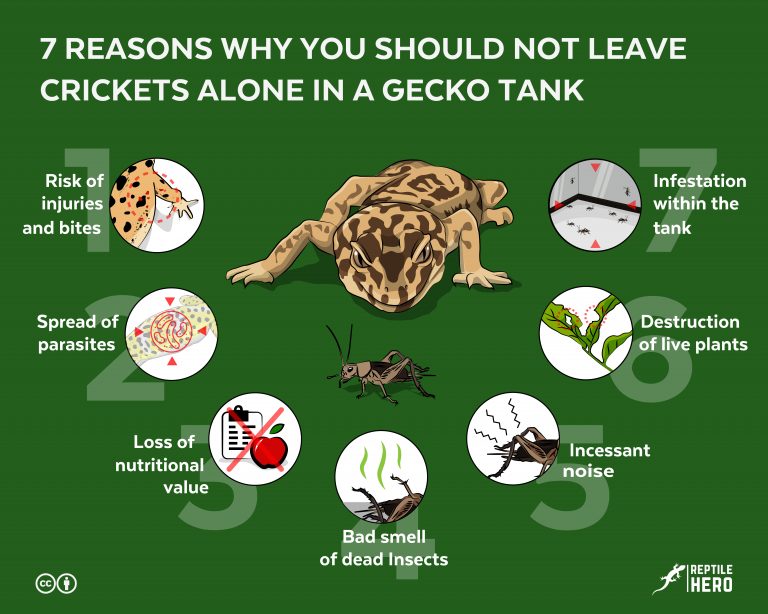Is Your Leopard Gecko Fat? 10 Signs [Infographic and Tables]
Have you wondered if your leopard gecko is skinny or chunky? Like us, your pet can also deviate from its optimum weight, especially if you neglect to provide for its needs adequately. So, aside from only minding how your facade impresses other people, you should also check and take paramount care of how your gecko looks for its own sake!
A leopard gecko over 18 months should weigh between 40–100 grams. Herpers consider any weight below the range as malnourished while any weight over it as obese. Four factors could influence its size: food, genes, overall health, and sex.
Keep on reading to see whether your gecko’s size is fit for its age.
Is Your Leopard Gecko Chunky or Skinny?
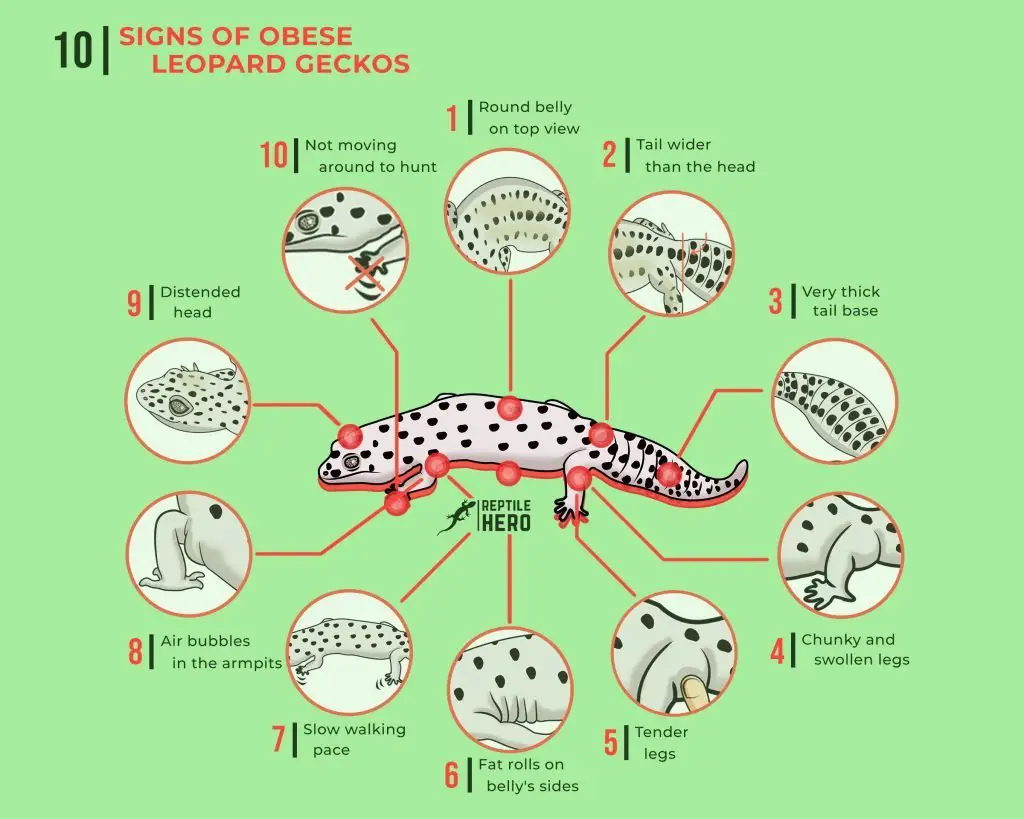
Over the years, our researchers have suitably established reliable data for knowing the appropriate heights and weights in people depending on age and gender.
However, for your gecko, there is no precise method to correctly deduce the most appropriate length and weight values since scientists have not published reliable growth charts.
As a result, the nearest data you can refer to at par with an officially standardized table is a chart compiled by gecko-enthusiast like us!
Below, you can refer to ranges of weights and lengths we have observed over the years.
While you should take this table with a grain of salt, you can still use this as your guide to gauge whether your reptile falls under or over the monitored values.
| Age (months) | Male Weight (grams) | Female Weight (grams) | Male Length (inches) | Female Length (inches) |
|---|---|---|---|---|
| <1 | 2–5 | 2–5 | 3 | 3 |
| 1 | 10–20 | 10–20 | 4 | 4 |
| 3 | 20–30 | 20–30 | 5 | 5 |
| 6 | 30–40 | 30–40 | 6 | 5–6 |
| 9 | 40–50 | 35–45 | 7 | 6 |
| 12 | 55–65 | 40–50 | 8 | 7 |
| 18 | 60–80 | 50–70 | 10–12 | 8–10 |
However, you should note that since these are empirical data for the more commonly owned morphs by herpers like me, variations could exist specifically to supergiants.
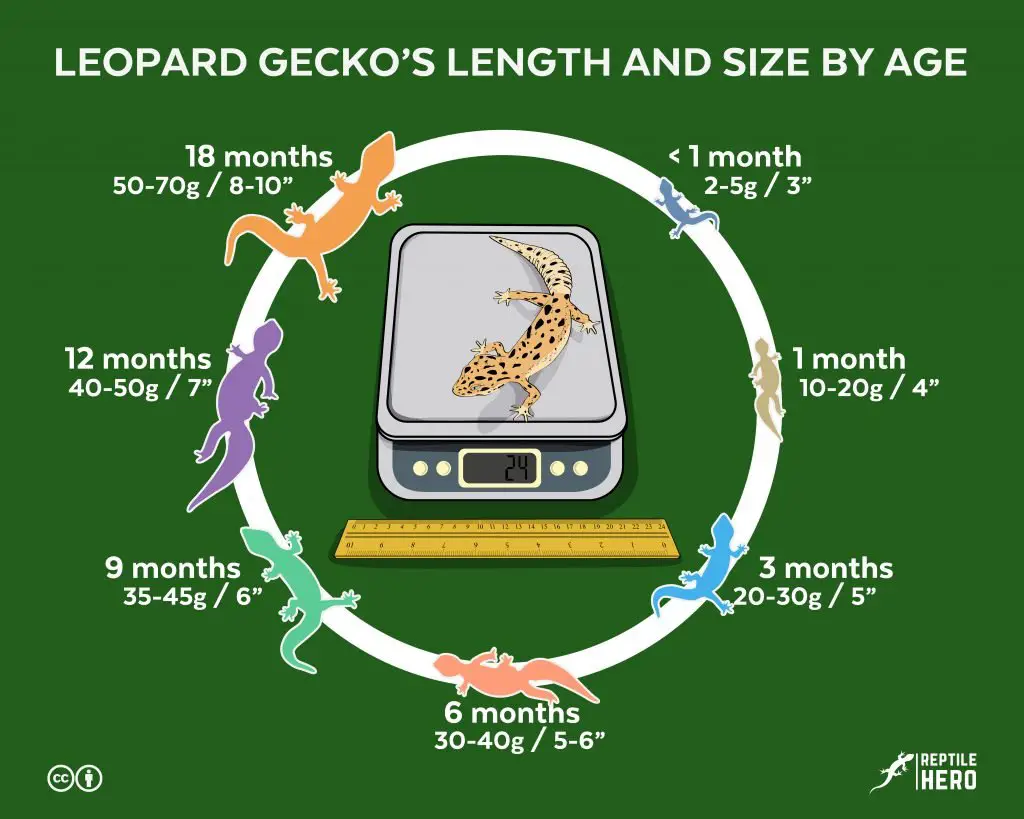
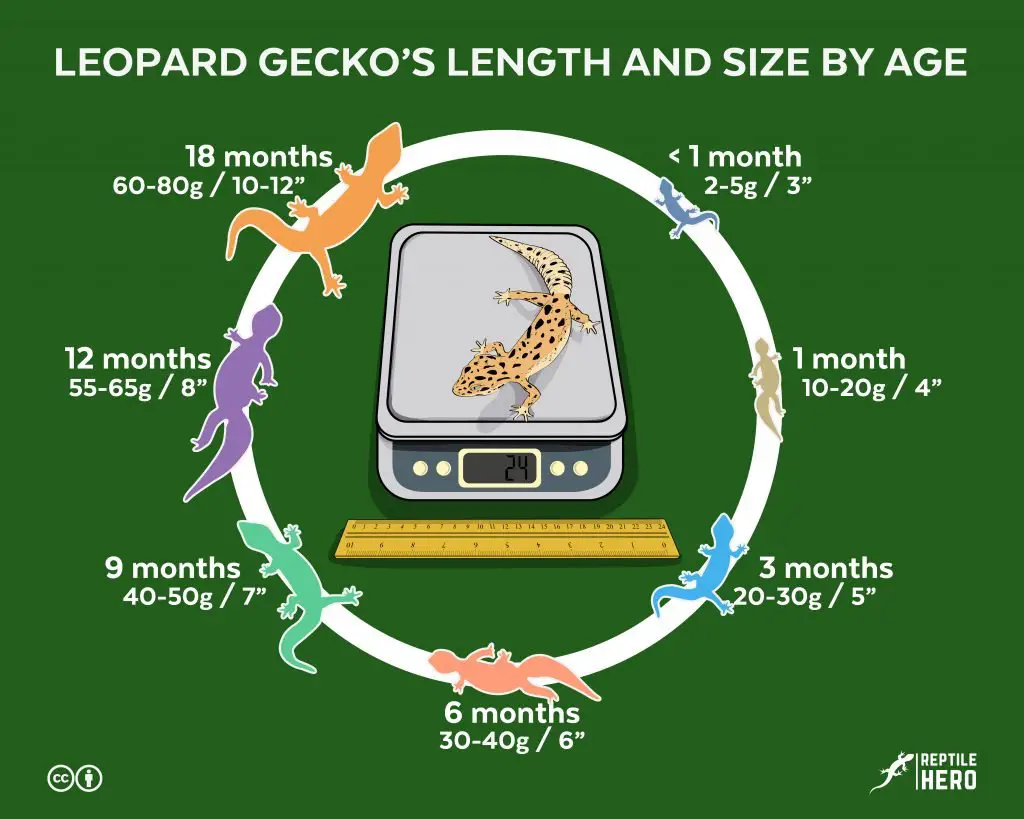
4 Signs of Malnourished Geckos
Until they reach past 30 grams in weight, juvenile leopard geckos may look skinny. However, upon maturity at 18 months, geckos weighing under 40 grams are considered underweight.
Aside from the number in the weighing scale, you should look out for these physical manifestations in an underweight mature gecko:
- the head appears more prominent than the body
- rib bones visibly emerge under the skin
- backbones protrude from the skin
- the tail looks thin and small
10 Signs of Obese Geckos
Typically, your full-grown leopard gecko should weigh between 40–100 grams; some are even pushing to 110–120 grams in supergiant morphs. If you note more than that, your reptile is probably fat.
However, you must not look at the numbers alone! If your gecko naturally has a small physique, 60+ grams could make it fat.
Since obesity is not uncommon in captive environments, you should beware of these exhibitable signs in a fat matured gecko:
- air bubbles in the armpits
- distended head
- fat rolls on belly’s sides
- round belly on top view
- very thick tail base
- tail wider than the head
- tender-to-touch legs
- chunky and swollen legs
- slow-walking pace
- not moving around to hunt
How Should Your Healthy Gecko Look?
Listing down traits of a skinny or chunky gecko could be hard to imagine. Hence, for your visual reference, below is a photo of how your healthy mature gecko should and should not look.
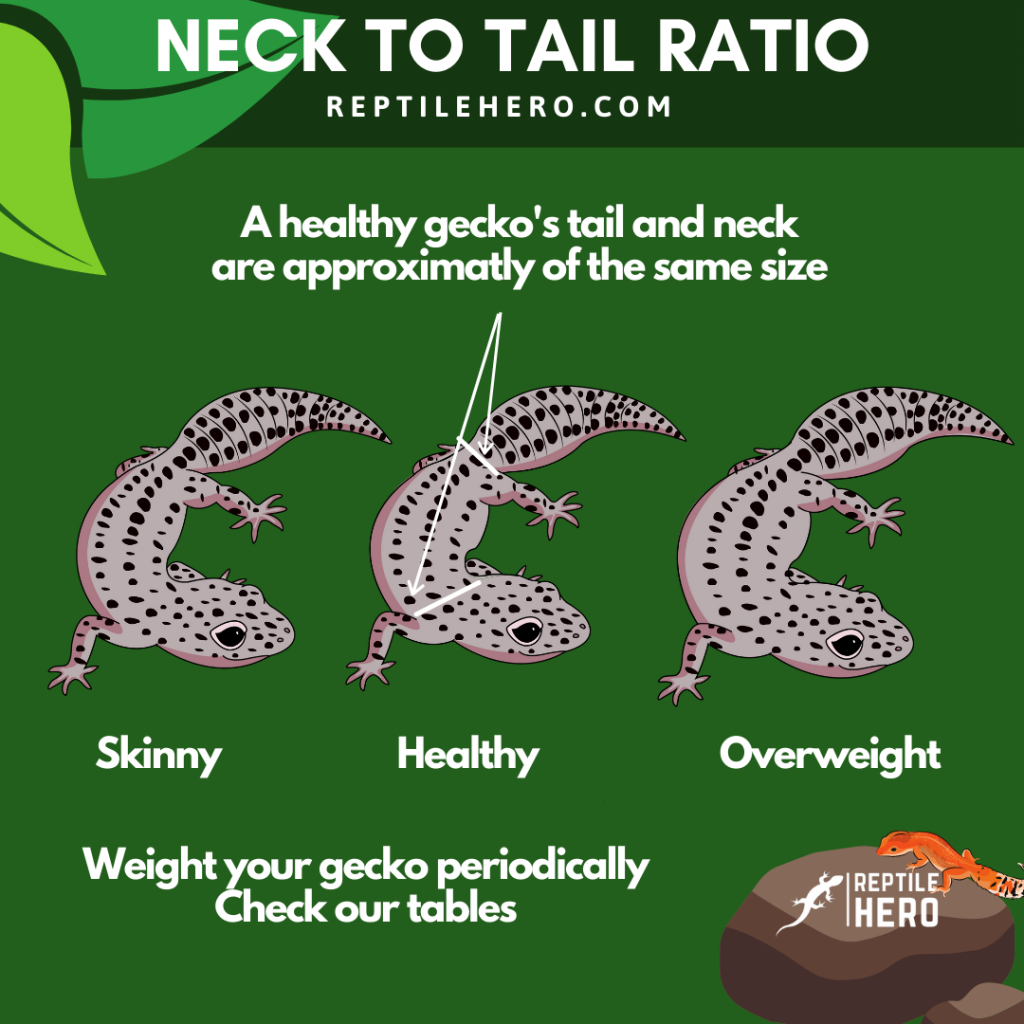
Aside from matching your gecko’s build in one of the images above, you could also test your gecko by releasing a live prey in the tank. Observe whether it is interested in hunting and catching the food or if it just sluggishly moves around.
This simple test can verify your recorded data and improve your care for your reptile.
3 Reasons For Gecko Weight Change
Some leopard geckos may grow more rapidly and reach maturity by 10 to 12 months. On average, healthy leopard geckos reach full adult size within the first year.
Meanwhile, these reptiles grow fastest during the first six months, where you feed them daily, and they shed often. You might even notice up to a thirty-gram weight gain during this timeframe. Despite this observation, you should never reduce your gecko’s food intake until over 18 months.
However, there are certain situations where weight changes drastically occur in your beloved leopard.
- Female geckos will gain weight before getting pregnant.
- After laying eggs, female geckos tend to lose a lot of weight.
- Affecting both sexes, losing weight during shedding is commonly noticed.
Swipe the Gecko Infographic Body Shape Below Left or Right!
4 Factors That Could Impact Your Gecko’s Size
Every leopard gecko is unique, just like how we do not look alike or how identical twins do not fully resemble one another.
Luckily, few trends seem to befit leopard geckos even with different body structures. Herpers observed these factors highly influencing your gecko’s size: diet and calorie intake, genetic traits, sex, and overall health.
Diet and Calorie Intake
Access to an adequate supply of high-quality food does not only make your gecko’s stomach full but also uplifts its general health to allow for natural growth.
Failure to give your gecko the minimal needs could result in a reptile that weighs less and falls shorter than the average observation from the table above.
Hence, you should avoid these recurrent practices that could contribute to malnourishment:
- Giving improper diet
- Failing to gut-load feeder insects
- Falling short in supplements
- Overhandling
On the other end, providing more food than needed by your gecko does not promote length surge way past the average.
However, continuing to do so could potentially risk your pet weighing more than what is expected of it, which you do not want to happen—even to yourself.
Thus, you must steer clear away from these customary actions exacerbating obesity:
- Overfeeding
- Feeding fatty feeder insects and fuzzy mice
- Offering freeze-dried insects
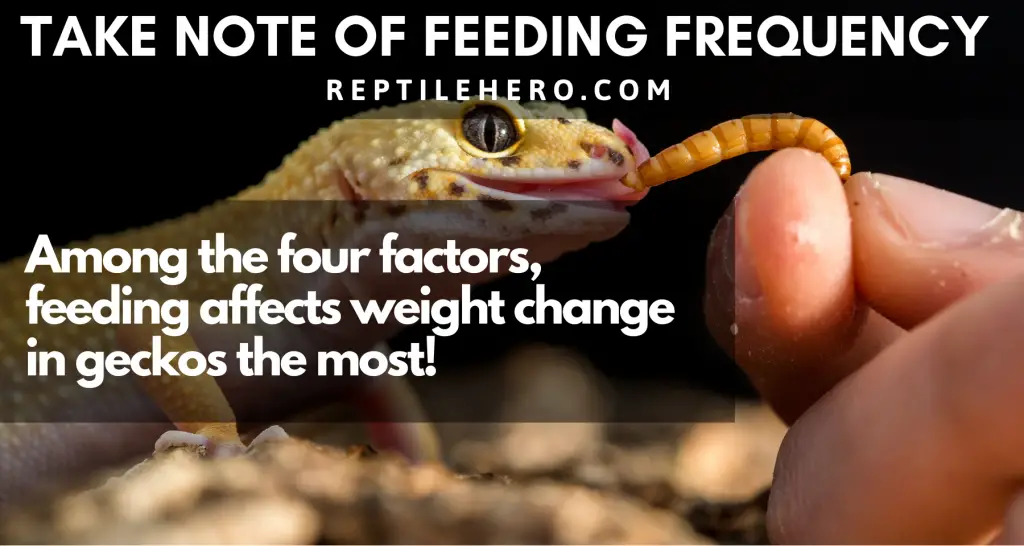
Genetic Traits
One of the factors impacting your gecko’s size, wherein it is out of your control, is its genes. The genetic material it inherits from its mother and father plays a crucial role in determining its weight and length.
If obesity or malnourishment runs in its bloodline, your gecko could be more prone to acquire either of the two when you recklessly fail to meet its needs.
Thus, it is also vital to have prior knowledge regarding your pet’s lineage to prepare yourself for possible illnesses better it could get in the future.
Aside from potential obesity, malnourishment, or health-related issues, genes also dictate other physical characteristics like patterns and colors.
Sex
Sex is another distinguishing factor you cannot control that influences your gecko’s size.
As outlined in the chart above, you can observe that male and female leopard geckos likely have similar weights and lengths until around three months at the juvenile stage. Meanwhile, as both are near maturity, male leopard geckos typically outweigh and outmeasure the female ones.
However, you should note that neither of the sexes contributes to a higher risk of becoming under or overweight in leopard geckos.
Overall Health
As an owner, the general welfare of your gecko is your topmost responsibility. Thus, aside from providing proper nourishment, you should address these husbandries accordingly to elude under or overweight in your reptile:
- Incorrect size enclosure
- Inaccurate temperatures
- Inaccurate humidity levels
- Insufficient hides
- Unmaintained habitat
- Wrong substrate
Overweight and Underweight Issues On Gecko’s Health

By properly meeting your gecko’s needs, you could avoid stress-induced malnourishment or obesity. However, if you are already in a case of having a chunky or skinny gecko, you might want to address it immediately, as both could worsen your pet’s health condition.
Underweight-related Issues
When your gecko is underweight, it is likely to infer that it already has a compromised immune system. Thus, the reptile is prone to contract illnesses caused by opportunistic pathogens.
Though a healthy gecko could manage to keep cryptosporidium parasites at bay, a skinny gecko might fail to do so. Hence, it could easily fall under a parasitic infection called cryptosporidiosis [1].
Cryptosporidiosis is not an uncommon illness a leopard gecko acquires when it is immuno-compromised. Neglecting treatment would put your gecko to lose its weight further until it dies. Commonly, a “stick tail” develops due to fat-loss on its tail.
Other observable symptoms of a crypto-infected may include:
- diarrhea
- frequent hiding
- lethargy
- loss of appetite
- rapid weight loss
Overweight-related Issues
When your gecko is overweight, this could lead to a concerning health issue affecting one of its primary organs. Obesity and lack of exercise could trigger hepatic lipidosis, commonly known as a fatty liver disease similar to humans [2].
Chunky geckos are commonly diagnosed with fatty liver disease. As the liver unsuccessfully performs its job well, your pet’s body could build up unremoved toxins. The abundance of fats suppresses its immune system, making the reptile susceptible to bacterial, fungal, or viral infections.
Aside from the apparent fat in your gecko’s body, other symptoms may include:
- anorexia
- edema
- lethargy
- swollen limbs
- weakness
- yellow skin, eyes, and gums
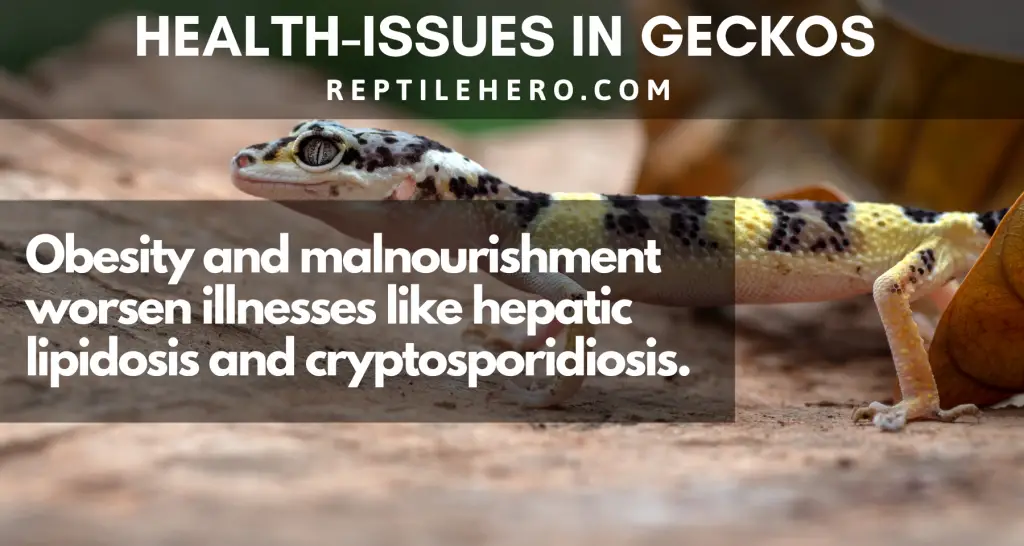
Takeaways
Though there is no single value to trust, a healthy adult leopard gecko’s average weight should fall between 40 to 100 grams.
An under or overweight gecko would manifest physical body changes, which serve as signs for its owner to observe.
Four factors could generally affect a gecko’s size: food, genes, sex, and overall health.
Obesity and malnourishment in geckos could trigger other health-related issues, such as cryptosporidiosis and hepatic lipidosis.
Source
[1] https://pubmed.ncbi.nlm.nih.gov/19303009/
[2] https://netvet.co.uk/exotic/lizards/fatty-liver-disease/

![How to Travel In a Car With Your Gecko? [6 Dos and 2 Don’ts]](https://www.reptilehero.com/wp-content/uploads/2021/12/car-ride-gecko-cc-768x614.jpg)

![Why is Your Leopard Gecko’s Nose Red? [9 Causes and Solutions]](https://www.reptilehero.com/wp-content/uploads/2021/10/Red-nose-gecko-cc-768x614.jpg)
![10 Reasons Why Your Gecko Is Sneezing [With Solutions]](https://www.reptilehero.com/wp-content/uploads/2021/03/Why-gecko-sneeze-cc-768x614.jpg)
![8 Reasons Why Your Gecko Lays Infertile Eggs [and 5 Tips]](https://www.reptilehero.com/wp-content/uploads/2021/02/G36-768x614.jpg)
